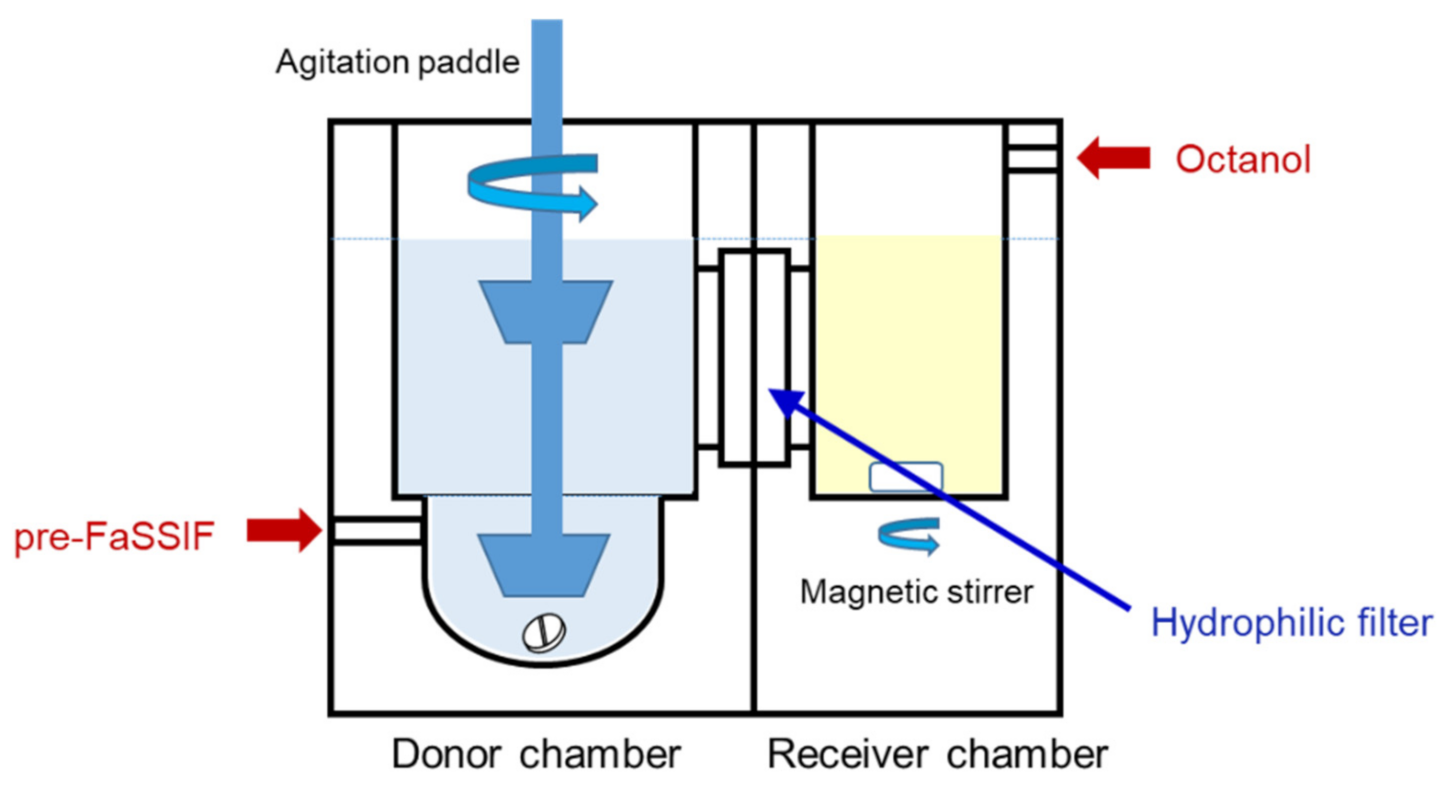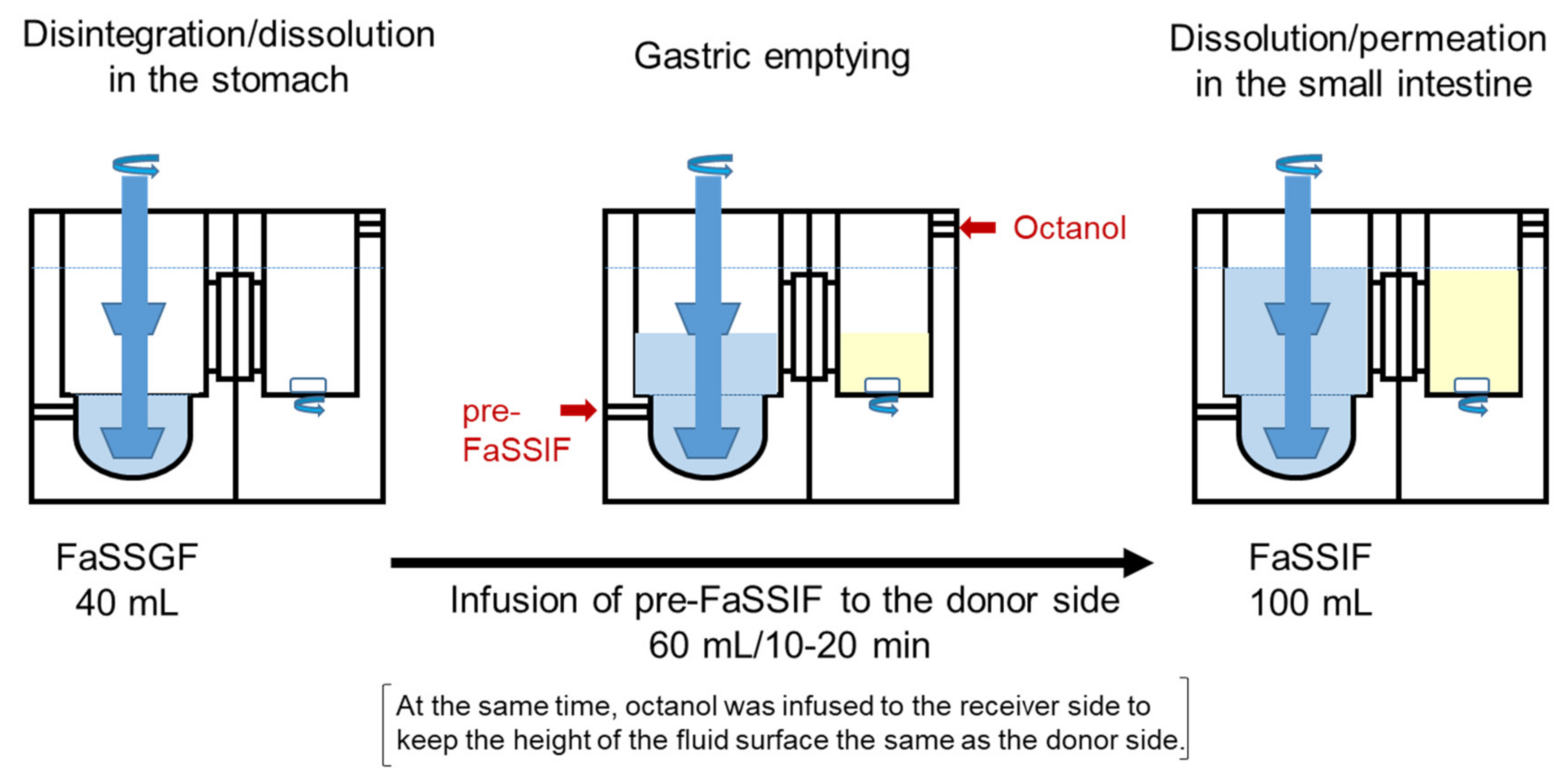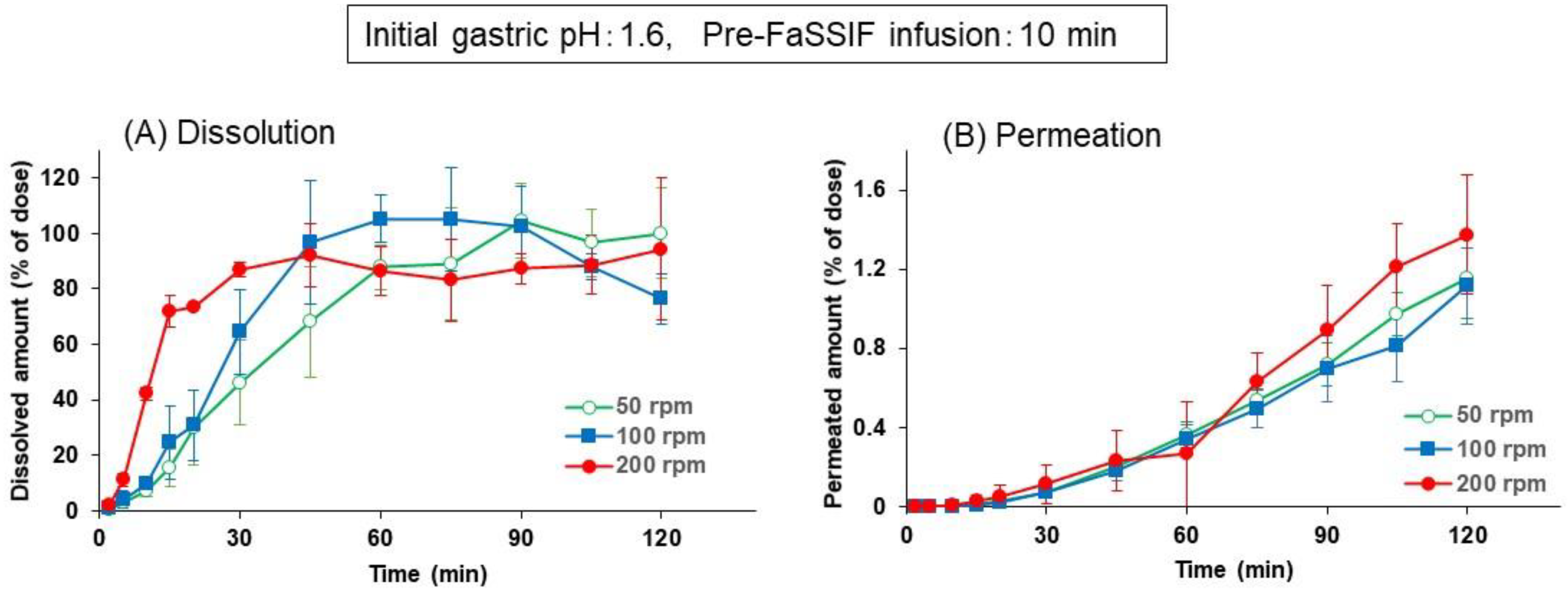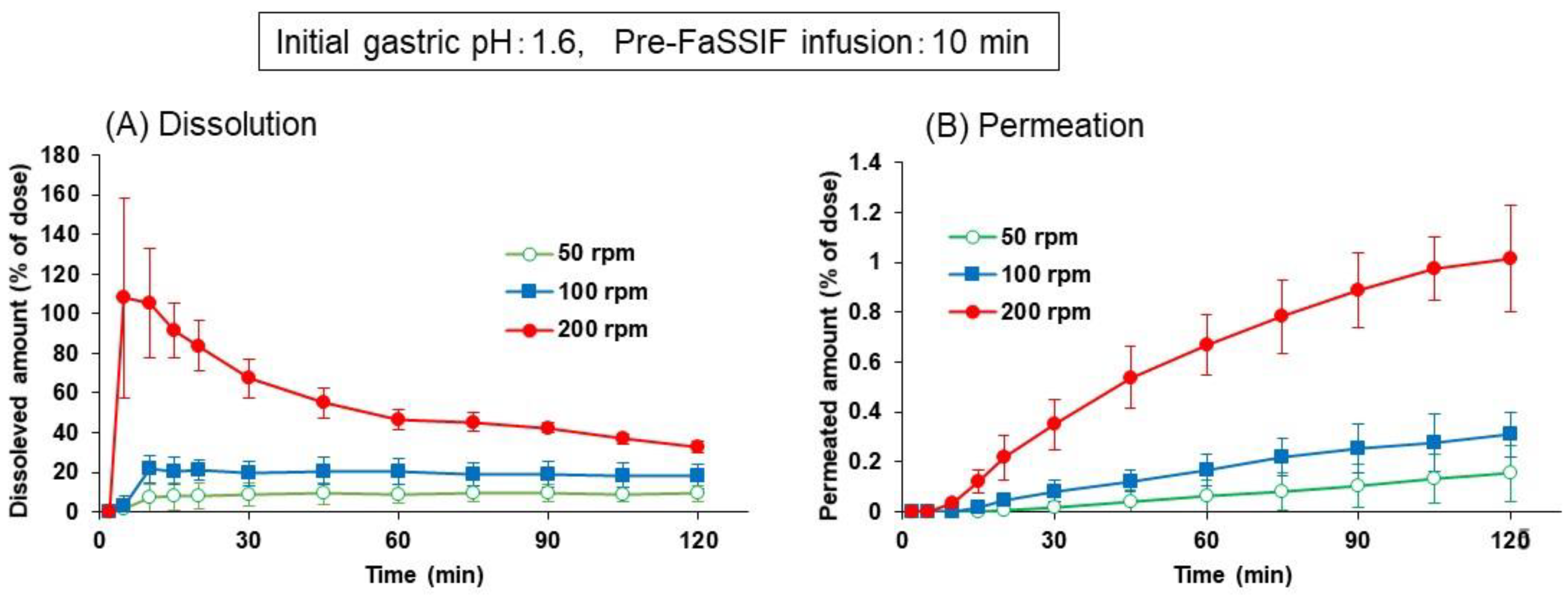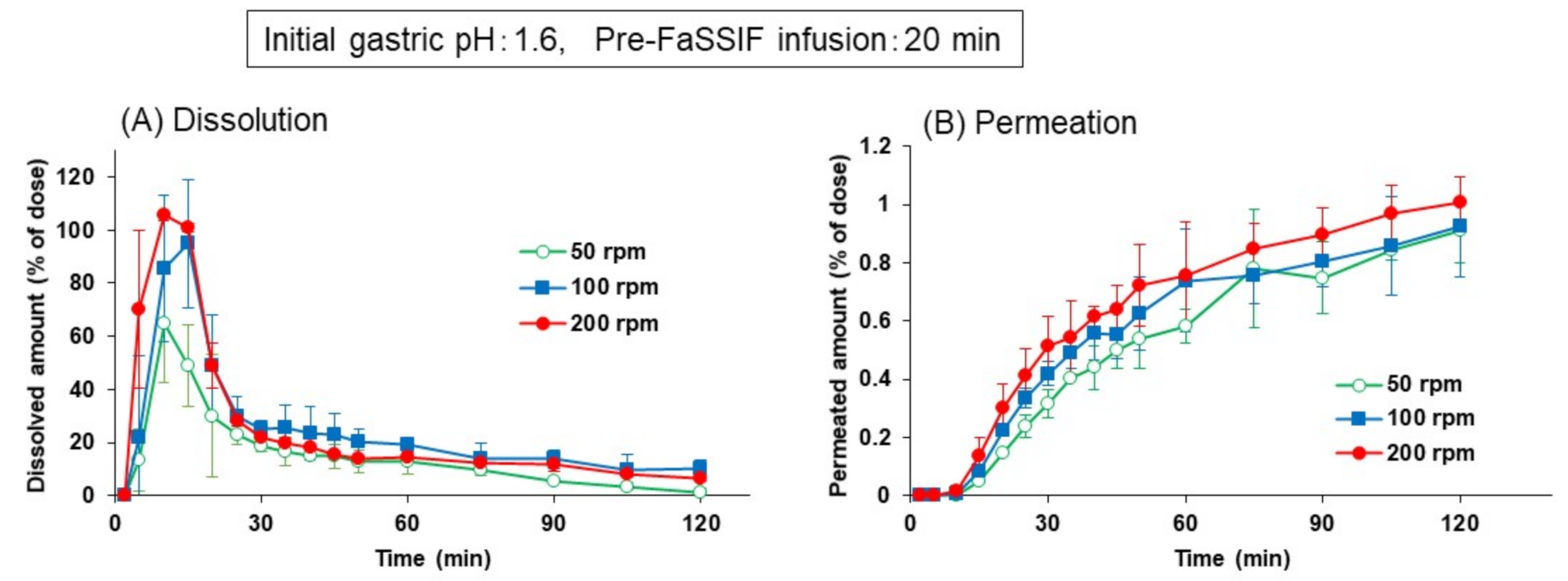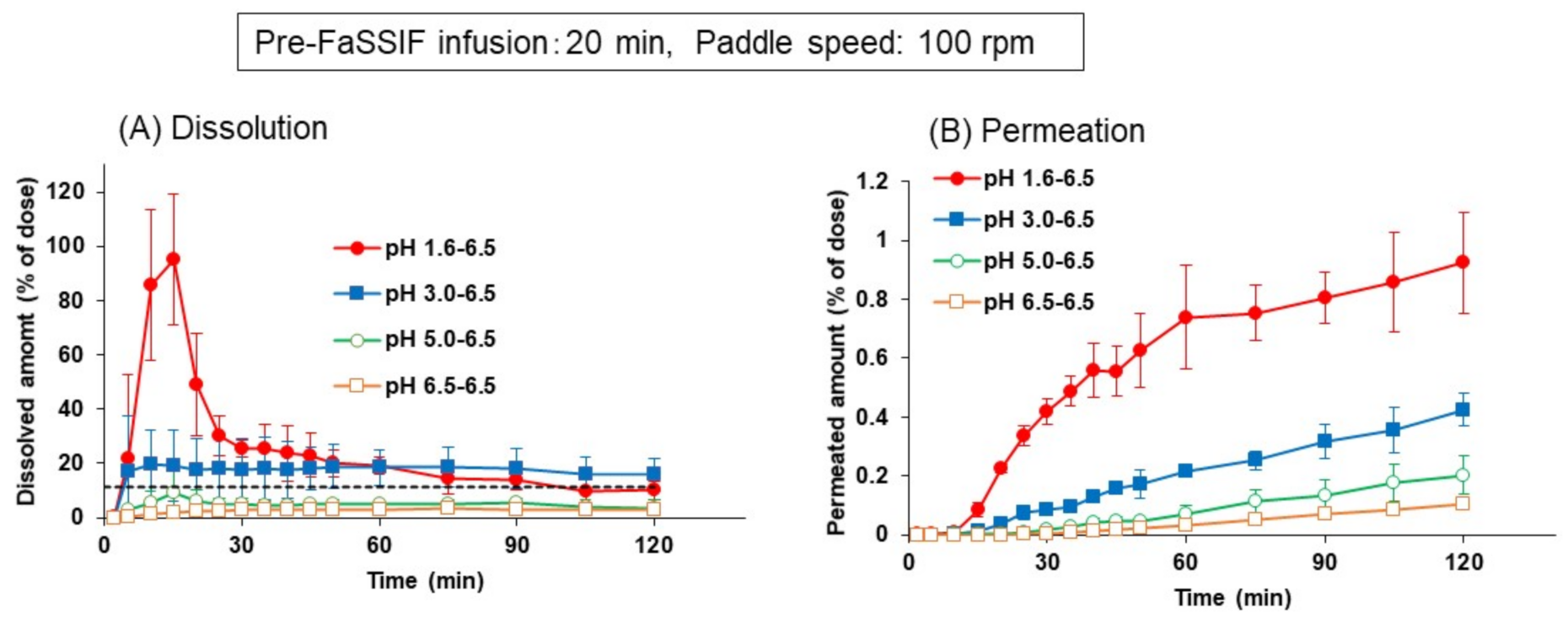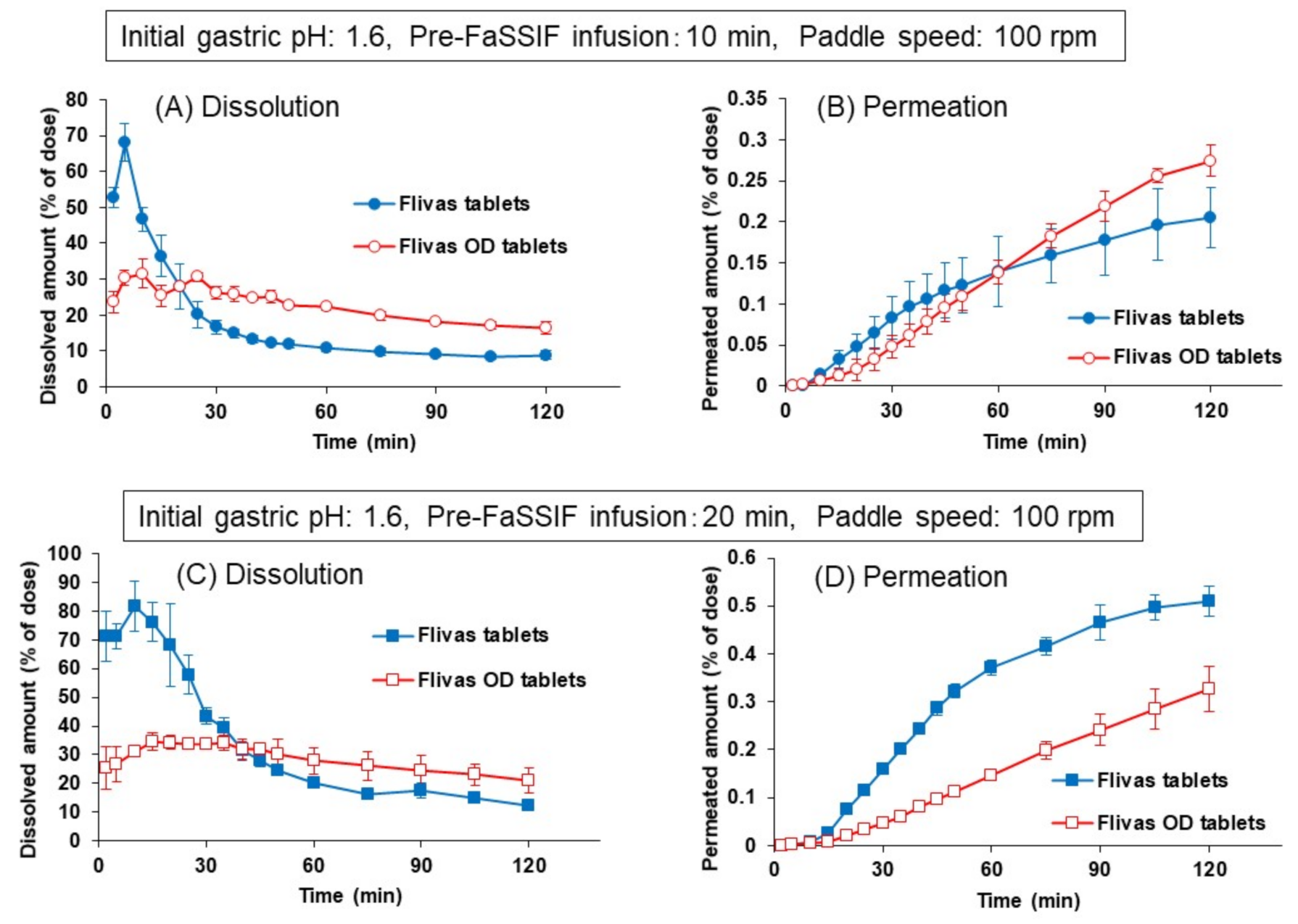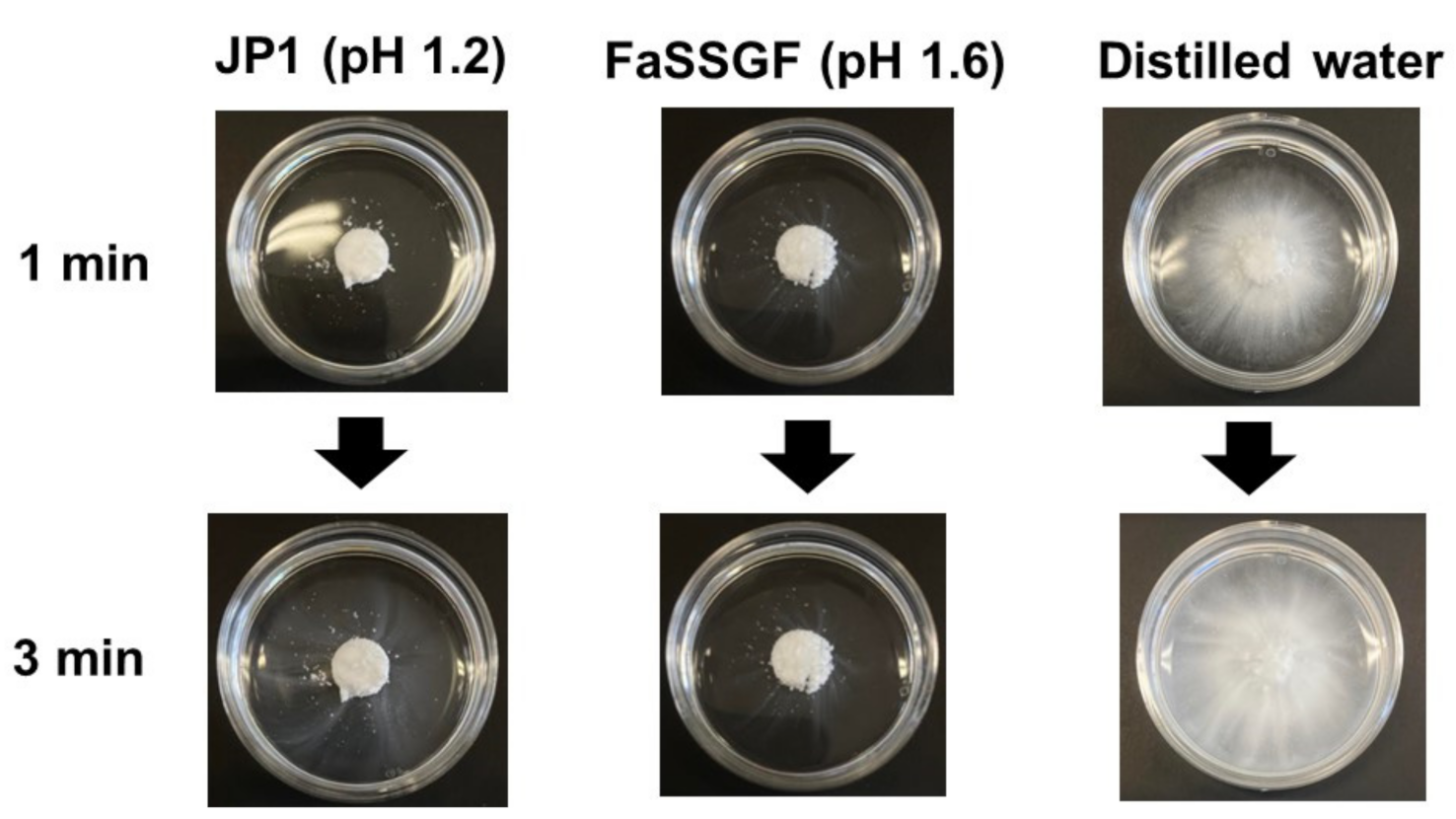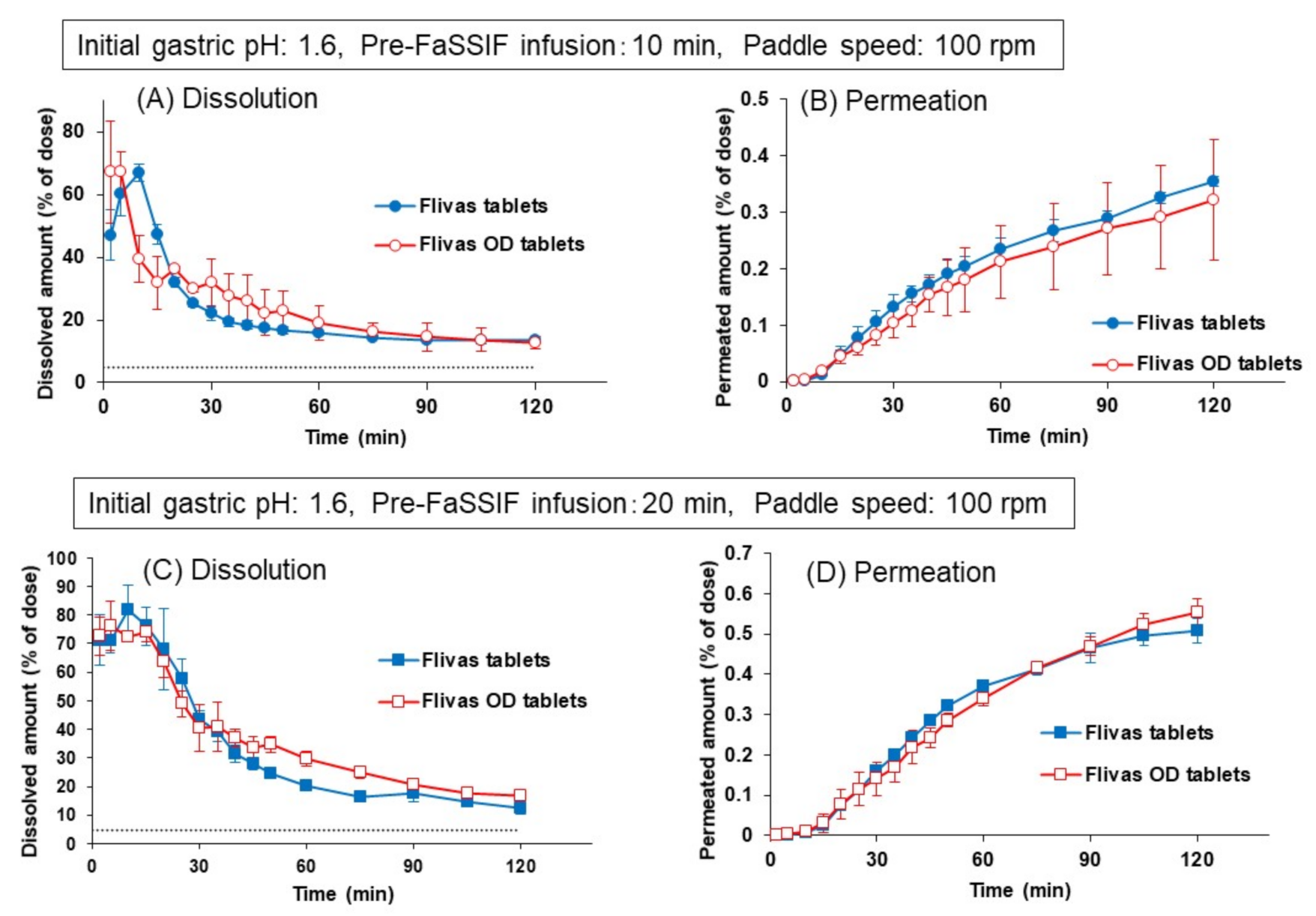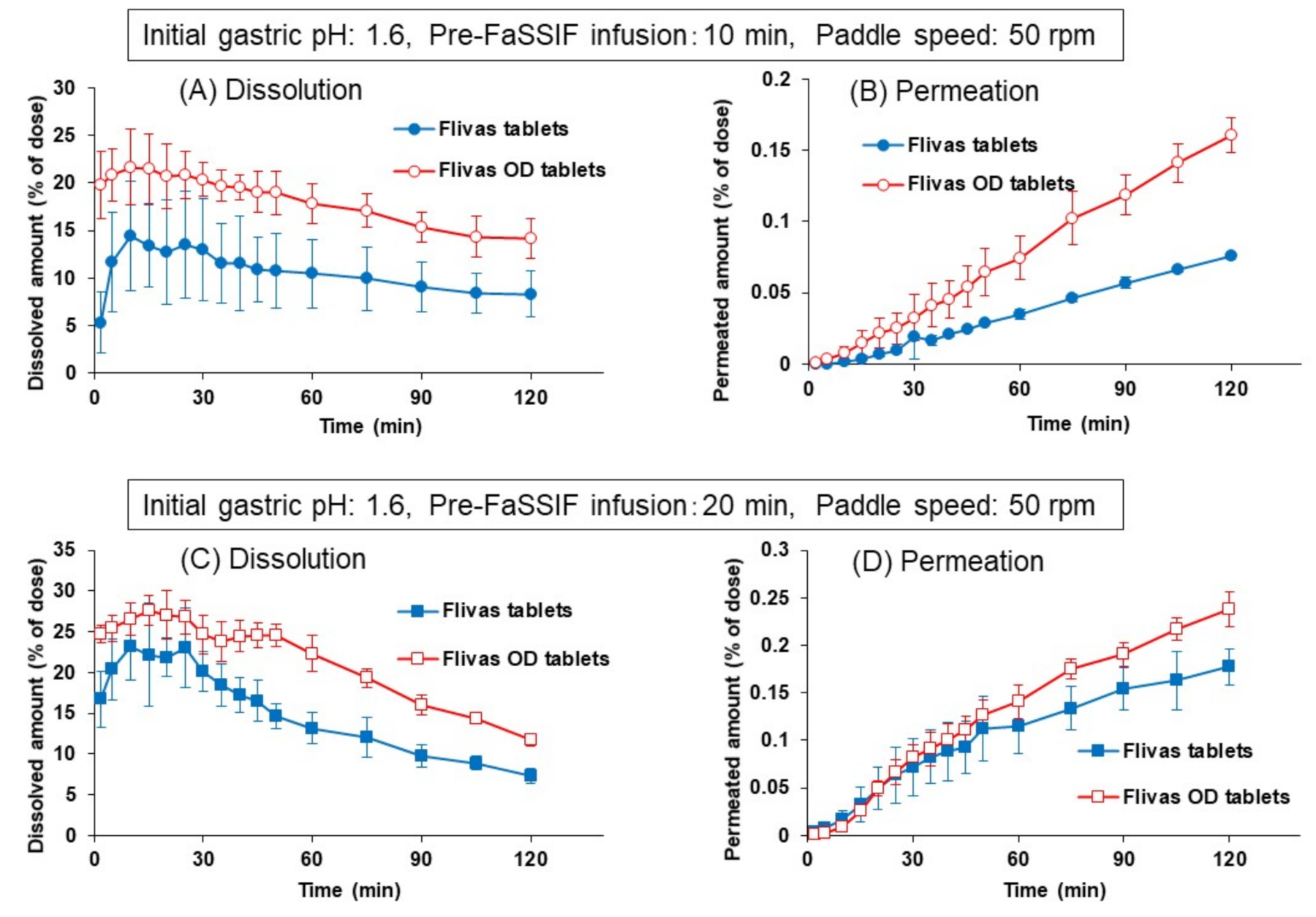1. Introduction
The bioequivalence (BE) study of oral dosage forms is performed to assure therapeutic equivalence of two drug products containing the same active pharmaceutical ingredient (API), by comparing the rate and extent of drug absorption after oral administration [
1,
2,
3]. After in vitro tests for drug release/dissolution, human BE study is usually performed using healthy adult volunteers. Subjects having undesirable diseases or who are taking concomitant medicines are excluded from these studies according to the exclusion criteria. This is to avoid the risk of adverse events caused by the test or reference products, and the study design with healthy subjects is rational. However, once the drug products are approved and put on the market, various patients having diverse chronic disorders, health conditions, or lifestyles may take them. Such patients often use generic drug products as a switch from original products. Switched products will show the same efficacy and safety as the original ones for most patients because they are proved to be BE. However, that may not be always the case for certain populations. As a typical example, poorly soluble basic drugs are known to be dissolved in the stomach at a low pH and are then transferred to the small intestine as a solution to be absorbed rapidly. In patients with achlorhydria or with concomitant use of proton pump inhibitors (PPIs), the dissolution of basic drugs in the stomach will be inhibited, and the absorption from the small intestine will be decreased. In those patients, the rate and extent of drug absorption becomes strongly dependent on the formulation design, and some BE products may show different profiles of absorption that could not be detected in a BE study with healthy subjects. Other factors of GI physiology such as gastric emptying rate, agitation strength, GI fluid compositions (including bile concentrations), and volumes can cause the inequivalent performance of BE products in the special population. Although the concept of “BE in the special population” is widely recognized as a critical issue when using a generic drug product, clear rules are not yet defined because of the lack of clinical evidence and the methodology to detect it.
Due to the less biorelevant conditions that are currently used in in vitro drug dissolution tests defined by the Pharmacopeia in each country (typically a paddle or a basket in 900 mL vessels), various kinds of in vivo predictive in vitro methods for investigating drug dissolution in the GI tract have been developed. Several types of multiple compartmental GI transfer systems have been developed so far, in which two or three dissolution vessels are connected by peristatic pumps for analyzing the drug dissolution in each part of the GI tract [
4,
5,
6,
7,
8,
9,
10,
11]. As one of those systems, a multicompartmental in vitro dissolution apparatus, the gastrointestinal simulator (GIS), was shown to be able to detect the effect of gastric pH on the dissolution profile of dipyridamole, a BCS class II weak base drug, which corresponded well to the clinically observed drug–drug interaction with famotidine [
12]. An additional function of drug partitioning to the octanol phase was also introduced to the GIS to observe the process of membrane permeation [
13]. Further, as a more complex system, the TNO gastro-intestinal model is designed to realistically simulate conditions in the GI tract. Although such systems are successful for simulating the performance of drug formulations in the GI tract, applications to the test these drugs in various GI conditions representing those in particular patients are limited because of their complex and large-scale systems, thus low throughput and difficulty in setting up the system for variable GI conditions.
In a previous study [
14], we have developed an in vitro system (named the Stomach-to-Intestine Fluid Changing (SIFC) system) which can reproduce the temporal changes in the pH, composition, and volume of the GI fluid in a single vessel equipped with one syringe pump. In the SIFC system, the fasted state gastric simulated fluid (FaSSGF) was used as an initial fluid in the vessel to which drugs could be applied as a powder or formulation. The concentrated fasted state simulated intestinal fluid (pre-FaSSIF) was then infused to the vessel at a constant speed to change the entirety of the fluid to FaSSIF (pH 6.5). For the applied drug or drug formulation, this process corresponded to the transit from the stomach to the small intestine after oral administration. One of the most advantageous points of this system is that it is possible to respond to a variety of GI conditions by simply changing the fluid pH or composition, and infusion rate of the GI system. Using this system, the effects of the initial gastric pH and dose strength in the formulation of telmisartan were observed to simulate dose-dependent intra-subject variability in the plasma drug concentration in human BE studies.
In this study, based on the previously developed SIFC system, a more biorelevant in vitro system (in vitro bioequivalence checking system (BE checker)) was newly designed to predict the BE of oral drug products in healthy and specific populations. Not only the dissolution but also the membrane permeation of drugs from marketed products were observed. As they are the GI physiological factors that influence the drug release/dissolution profile, effects of the initial gastric pH, gastric emptying rate, and the agitation strength in the GI tract were investigated using the BE checker to demonstrate the risk of bioinequivalence in special populations.
2. Materials and Methods
2.1. Materials
Hank’s balanced salt solution (HBSS) was obtained from Gibco Laboratories (Lenexa, KS, USA). Egg-phosphatidylcholine (lecithin) was obtained from FUJIFILM Wako Pure Chemical (Osaka, Japan). Sodium taurocholate (NaTC) was obtained from Nacalai Tesque (Kyoto, Japan). Seloken® tablet 20 mg and Persantin® tablets 25 mg were obtained from AstraZeneca (Osaka, Japan) and Nippon Boehringer Ingelheim (Tokyo, Japan), respectively. Flivas® tablets 25 mg and Flivas® orally disintegrating (OD) tablets 25 mg were obtained from Asahi Kasei Pharma (Tokyo, Japan). All other reagents used were of the highest purity.
2.2. Design of In Vitro Bioequivalence Checking System for Oral Drug Product (the BE Checker)
The BE checker developed in this study is illustrated in
Figure 1. A hydrophilic filter with a pore size of 0.22 µm (Durapore membrane filter, MERCK Millipore, Burlington, MA, USA) was mounted between the donor and receiver chambers. The effective surface area of the filter was 6.60 cm
2. Both chambers were made of acrylic plastic. The volume of the donor chamber was 40 mL in the bottom, which corresponds to the stomach, and the model had a total volume of 100 mL. The volume of the receiver chamber was set to 30 mL.
The compositions of FaSSGF and FaSSIF used in this study are summarized in
Table 1. At the beginning of the experiment, the bottom of the donor chamber was filled with 40 mL of FaSSGF. After administration of the tablet, 1.67-times concentrated FaSSIF (pre-FaSSIF) was infused into the donor chamber to shift the donor fluid to FaSSIF. Since HBSS contains 19.45 mM
d-glucose, the final concentration of the
d-glucose in the FaSSIF was 25 mM.
The pH of the FaSSGF was adjusted to 1.6, 3.0, 5.0, or 6.5 using the diluted HCl and/or NaOH solution. Pre-FaSSIF was prepared to finally construct 100 mL of FaSSIF (pH 6.5) after its addition to 40 mL of FaSSGF.
The receiver chamber was empty at the beginning, and octanol was then infused into the receiver side at a rate to keep the height of the fluid surface the same as the donor side.
2.3. Simultaneous Evaluation of Disintegration/Dissolution and Permeation of the Drugs from the Tablets Administered to the BE Checker
Experimental conditions designed to represent the GI physiology in the fasted state are shown in
Figure 2. A tablet was administered to 40 mL FaSSGF in the bottom of the donor chamber. After agitation for one minute as a disintegration/dissolution phase, 60 mL pre-FaSSIF was infused into the donor chamber at a constant rate for 10 or 20 min using a syringe pump as gastric emptying phase. At the same time, water-saturated octanol was infused into the receiver side. After infusion, dissolution and permeation of the drug in the small intestine were evaluated. Samples were taken from each side of the chamber at the specified time. Donor samples were immediately filtered through a membrane filter (Millex®-LH, pore size: 0.45 µm, Millipore, MERCK Millipore, Burlington, MA, USA) to remove any undissolved and precipitated drug. The volume of each side was maintained by adding fresh fluid after sampling. Samples were stored at −80 °C until analysis.
2.4. Analytical Methods
Drug concentrations in the samples were determined using an ultra-performance liquid chromatography (UPLC) system (ACQUITY® UPLC, Waters, MA, USA) equipped with a tandem mass spectrometer (ACQUITY TQD, Waters, MA, USA). In metoprolol and dipyridamole, the donor and receiver samples were diluted with 0.1% formic acid/acetonitrile (50:50) and water/acetonitrile (20:80), respectively. In the case of naftopidil, the donor and receiver samples were diluted with 0.1% formic acid/methanol (50:50) and water/methanol (20:80), respectively. A reversed-phase Waters Acquity UPLC BEH C18 analytical column (50 mm × 2.1 mm, 1.7 µm particle size) was used with a mobile phase consisting of 0.1% (v/v) formic acid (solvent A) and acetonitrile containing 0.1% (v/v) formic acid (solvent B) with a gradient time period. In the case of naftopidil, 0.1% (v/v) formic acid was used as solvent A, and methanol was used as solvent B. The initial mobile phase was 98% solvent A and 2% solvent B pumped at a flow rate of 0.3 mL/minutes. Between 0 and 1.0 min, the percentage of solvent B increased linearly to 95%, which was then maintained for 1.0 min. Between 2.01 and 2.5 min, the percentage of solvent B decreased linearly to 2%. This condition was maintained until 3 min had pased, at which time the next sample was injected into the UPLC system. All samples were injected at a volume of 5 μL into the UPLC system. The ionization conditions for the analysis of metoprolol were as follows: electrospray ionization condition, positive mode; source temperature, 150 °C; desolvation temperature, 400 °C; cone voltage, 10 V; and collision energy, 50 V. Precursor and production ion (m/z) were 267.67 and 77.05, respectively. The ionization conditions for the analysis of dipyridamole were as follows: electrospray ionization condition, positive mode; source temperature, 150 °C; desolvation temperature, 400 °C; cone voltage, 30 V; and collision energy, 48 V. The precursor and production ion (m/z) were 505.33 and 385.48, respectively. The ionization conditions for the analysis of naftopidil were as follows: electrospray ionization condition, positive mode; source temperature, 150 °C; desolvation temperature, 400 °C; cone voltage, 40 V; and collision energy, 30 V. Precursor and production ion (m/z) were 393.39 and 190.09, respectively.
4. Discussion
Although various in vitro systems have been developed and used to assess the bioavailability and/or bioequivalence of oral drug products, starting with a simple dissolution test, it is fair to say that no in vitro systems can perfectly mimic these highly complex in vivo drug absorption processes. For all systems, there are some pros and cons. With those as a basic premise, we have designed a new in vitro system, the BE checker, for testing the BE of oral drug products with the following questions in mind;
- ✓
How is the system biorelevant?
- ✓
How can the various physiological conditions in the GI tract be reflected?
- ✓
What kind of data can be obtained from evaluating BE?
- ✓
What is the throughput and cost-performance?
As a biorelevant system, it is essential to expose drug products to different environments in the GI tract, to those in the stomach first, and then to those in the small intestine. Multiple compartmental GI transfer systems reproduced these processes by connecting several vessels filled with biorelevant fluids [
4,
6,
7,
8,
9,
10,
12,
13]. Small particles or dissolved drugs in the fluids were transferred from one vessel to the next using a peristatic pump to mimic a GI transit in vivo. Although such compartmental systems are successful in observing the disintegration/dissolution of drug formulations in each part of the GI tract, systems are relatively large and complicated. In addition, the peristatic pump sometimes fails to adequately transfer the drug particles that are not dissolved or yielded by precipitation.
In the BE checker, the GI transit of drug formulations or drugs was embodied by changing the surrounding environments while the drugs were kept in the same vessel. This is the most important and advantageous feature of this system, which was adapted from the previously developed SIFC system [
14]. This concept is noted as “environmental changes in the GI tract from the stomach to the small intestine are reproduced in one chamber by gradually changing the fluid pH, composition and volume without transferring drugs or drug formulations”. Only one donor chamber equipped with one syringe pump is needed to achieve this process in the BE checker.
Another point to be addressed is that a receiver chamber was added to the system, which, when equipped with another pump to infuse octanol as a receiver fluid, can observe the membrane permeation process of the dissolved drug. We have already developed a small-scale, side-by-side chamber system and dissolution/permeation (D/P) system to investigate the oral absorption of drugs, mainly the fraction/dose absorbed from the small intestine (Fa). In the D/P system, a Caco-2 cell monolayer was used as a model membrane of the human intestine, and dissolved and permeated amounts (during the defined period) were measured after the addition of the drug to the donor chamber as a powder. A permeated amount in the D/P system was then converted to the Fa found in humans by using a standard curve obtained in advance using various marketed drugs. The D/P system is now used to screen the oral absorbability of APIs as well as to check the effect of food intake or different formulations on it [
17,
18,
19]. In the BE checker, instead of a Caco-2 cell monolayer, a hydrophilic filter was mounted between the chambers to prevent the mixing of donor and receiver fluids. As a receiver fluid, octanol was used because the partition of octanol is known as a good surrogate for drug permeation across the intestinal membrane. In an in vitro bi-phasic system, octanol is used as an absorptive compartment [
11]. Shi et al. have measured the time-profile of a drug amount partitioned to octanol from the dissolution medium in a bi-phasic system and reported its high possibility of assessing the drug absorption profile in vivo [
20]. In the BE checker, the height of the fluid surface on both sides is kept always the same by adjusting the octanol infusion speed. The surface area available for drug permeation gradually increases as the amount of the fluid increases. This may partially reflect the in vivo process of fluid spreading into the intestinal tract to increase the membrane surface area for drug absorption.
As with the case of a D/P system, the amount of the permeated drug (% of dose) in the BE checker was much smaller than that in vivo absorption (Fa). This is simply due to the lower permeation (absorption) clearance of the filter/octanol system in the BE checker than that in the in vivo absorption from the small intestine because of the smaller membrane surface area/volume ratio (A/V ratio) in this system. To evaluate the Fa from the data from the BE checker, the same method as that used for a D/P system is applicable in that the correlation between the permeated amount and Fa was used as a standard curve. Additionally, it is possible to convert the drug permeation profile in the BE checker to its plasma concentration profile after oral administration using in silico PK modeling. The obtained parameters such as AUC and Cmax will then be used to predict the BE of the test formulation. This is the next project to make the BE checker more useful for BE analysis using in vitro–in silico–in vivo extrapolation (IVISIVE). The study is currently in progress and will soon be reported.
In this study, the BE checker was designed as a 1/4 scale model of the human GI tract in volume. In some cases, drug products containing a 1/4 dose API of maximum dose strength are commercially available. By using a 1/4 dose strength product, the result in the BE checker can be regarded as representing the performance of the product with maximal dose strength in vivo, although the ratio of other excipients might be different. This is to reduce a cost and increase the throughput of the experiment. If necessary, it is not difficult to prepare a 1/1 scale system with a similar shape and functions.
The fasted state fluid volume in the stomach immediately after the ingestion of 150 mL of water (standard volume used for human BE study in Japan) was reported as 160–200 mL [
21]; thus, the initial volume of FaSSGF was set to 40 mL in the BE checker. The final volume of the donor chamber (as FaSSIF) should correspond to the volume of the small intestine. However, in this study, it was defined as 100 mL despite the fact that the fasted state intestinal volume was reported to be around 100–200 mL, even after the ingestion of 250 mL of water [
22]. This is due to the absorption of water by the small intestine; thus, it was assumed that the total volume of water to which drugs are exposed to in the small intestine is larger than the reported value. To determine whether the final volume of FaSSIF in the BE checker is adequate or not to assess BE, additional studies should be done to compare the results in the BE checker with those in human BE studies for various drug products. Those studies are now on going and will be reported in the near future.
Other factors of the GI physiology relating to drug dissolution/absorption were also reflected in the experimental protocol of this study by considering the variation among patients. Among them, agitation strength in the stomach is the most difficult to be parameterized for in vitro study because in vivo strength in the stomach is not uniform, and the peristaltic movement is too complex to correctly mimic with paddle rotation. In the results using the Seloken
® tablet (
Figure 4), a 200-rpm paddle speed in the BE checker gave a dissolution profile similar to that of metoprolol observed at 50 rpm of the paddle apparatus (in 900 mL vessel) [
15]. Although a 50-rpm paddle speed is often used in dissolution tests, it does not necessarily reflect the in vivo situation properly, and in vivo agitation strength is generally considered to be weaker [
23]. In this study, including the inter-subject variability, following experiments were done at three different paddle speeds, 50, 100, and 200 rpm.
Although human gastric pH is generally considered to be less than 2 in fasted condition, it was reported that a higher gastric pH (>3) was detected in about 10% of subjects, even among young healthy people [
24]. In the elder population, a relatively high percentage of achlorhydric subjects whose gastric pH is almost neutral in all conditions was found in Japan [
25,
26,
27]. To reflect these inter-subject variabilities, in this study, the initial gastric pH was varied from 1.6 to 6.5, as shown in
Figure 7.
In the study with the BE checker, the infusion time of pre-FaSSIF corresponds to the gastric emptying time in vivo. In our previous report, in which the gastric emptying rate of the ingested fluid was evaluated in humans, the half-life of the fluid emptying was calculated as 3–5 min [
21]. Takeuchi et al. reported that when the gastric half-life was set to 8 min, multiple compartment systems gave the most relevant dissolution profile of propranolol and metoprolol for simulating its plasma concentration profile in humans [
4]. Therefore, we have employed 10 and 20 min as the pre-FaSSIF infusion times. In addition, since longer half times for gastric emptying were also presented in some reports [
28,
29], we have checked the dissolution and permeation profiles of dipyridamole by changing the pre-FaSSIF infusion time to 30 min as well as to 10 and 20 min. A thirty-minute infusion time gave the similar results to those obtained with a 20-min infusion time (data not shown). Subsequent studies were then performed with 10 and 20 min of pre-FaSSIF infusion.
Results in
Figure 5;
Figure 6 clearly indicated the importance of both the agitation strength in the stomach and the gastric emptying time to evaluate the oral absorption of dipyridamole, which dissolved rapidly in the stomach under low pH conditions and then precipitated in the small intestine. In the patients with low agitation strength and fast gastric emptying, the absorption of dipyridamole might decrease due to a less supersaturated dissolution in the stomach. This is also the same for the patients with high gastric pH, as demonstrated by the experiments with various initial FaSSGF pHs (
Figure 7). Clinically, the absorption of dipyridamole is known to be inhibited by co-medication with PPIs due to elevated gastric pH [
27]. The results with the BE checker corresponded well to the in vivo observations of the decreased absorption of dipyridamole in such patients.
Although the effects of GI physiological factors such as gastric agitation strength, emptying time, and fluid pH on oral drug absorption primarily depend on the physicochemical properties of APIs, if the effects are also formulation-dependent, it is possible to affect and deviatethe bioequivalency of the products in special populations. The ordinary and OD naftopidil tablets, which have been proved as BE in human BE studies, were used to check the possibility of bioinequivalence in special GI situations. As a result, in the first experiment, the OD naftopidil tablets showed slow and incomplete dissolution profiles in the BE checker compared to the ordinary tablets under standard experimental conditions (initial gastric pH was 1.6, paddle speed was 100 rpm, pre-FaSSIF infusion time was 10 or 20 min), even though the OD tablet was designed to disintegrate rapidly in the oral cavity. It was revealed that the solubility of naftopidil in a solution containing a high concentration of HCl, such as FaSSGF or JP1, is limited by a solubility equilibrium with chloride ions and, in such solutions, a gel-like layer was formed on the surface of the OD tablets due to the aggregation of the quickly dissolved and precipitated naftopidil as a complex with chloride ions (
Figure 9). The effect of the gel-like layer was not observed in the in vivo BE studies (thus being proved as BE) because the OD tablets were quickly disintegrated and dispersed in the ingested water (or in the saliva) before arriving in the stomach. To mimic this situation, a 1-min disintegration time in water was added to the experimental protocol. Since this new protocol is relevant to the process of in vivo oral drug administration, subsequent studies including those with ordinary tablets were done according to it.
In the conditions where initial gastric pH was 1.6 and the paddle speed was 100 rpm, the ordinary and OD tablets showed similar dissolution and permeation profiles regardless of the pre-FaSSIF infusion time (
Figure 10), suggesting the BE of these two products in the healthy population. However, this might not be true for the special patients whose gastric agitation strength is weaker. As shown in
Figure 11, low paddle speed (50 rpm) caused the difference in the dissolution profile between both naftopidil products, which was less dissolved in the ordinary tablets than in the OD tablets. In the case of the OD tablets, rapid disintegration can progress the initial dissolution of naftopidil under low pH conditions, even with a low agitation strength, whereas the dissolution was highly inhibited in the ordinary tablets due to the slow disintegration in those conditions. This effect was more distinct when the pre-FaSSIF infusion time was short, although the difference was still observed at 20 min of infusion time.
The similarity level between the two formulations were quantified by calculating f
2 values for the time-profile of the permeated drug amount (% of dose). Since an f
2 function is usually applied to the dissolution profile in BE dissolution studies [
3], the adequacy or rationality of applying this function to the drug permeation profile in the BE checker has not yet been confirmed. However, considering the features of this function [
30], calculated f
2 values can give some indications of the similarity level of the drug permeation time profiles for both products. If the border of the similarity and dissimilarity was set to 50, the result in
Table 2 implies the risk of bioinequivalence in the patients with weak gastric agitation strength. It is possible to suggest that the two formulations may become bioinequivalence inpatients with gastric diseases or gastrectomy and elder or younger patients, although there is no clinical evidence to prove this at the present.
Currently, the use of in silico models and simulation technologies are accelerated and are expected to make a “virtual BE study” feasible in the near future [
31]. However, even with a highly sophisticated in silico program, it is still difficult to predict the entire oral drug absorption process from various formulations under various GI conditions with a high reliability. A combination with biorelevant in vitro data is essential for the use of in silico technology in the assessment of the BE of oral drug products. As a next study with the BE checker, in vitro drug permeation data will be converted to its plasma concentration time profile in silico to predict pharmacokinetic parameters such as C
max and AUC in the healthy and special populations.
